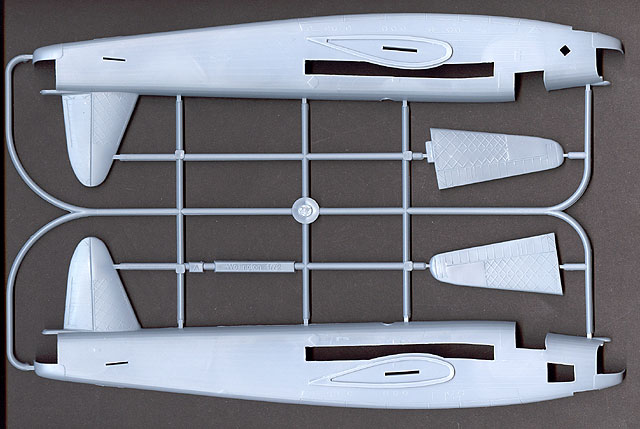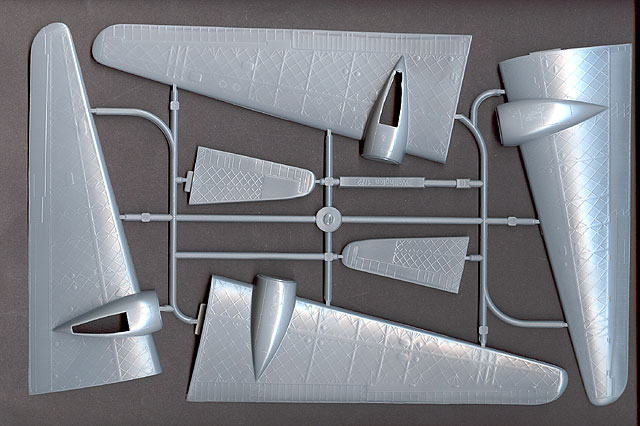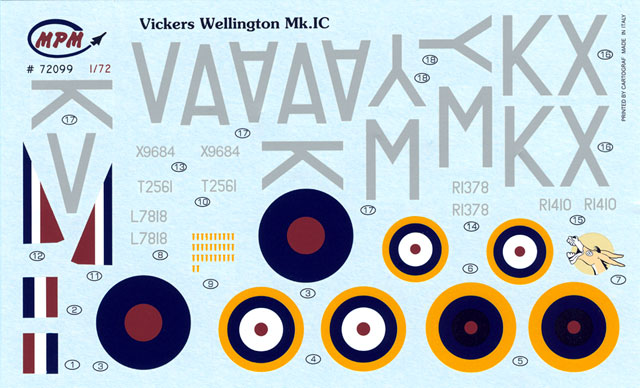|
S
u m m a r y
|
| Catalogue No.: |
72099 |
| Contents and Media: |
115 long-run injection moulded parts
in grey styrene; 13 parts in inejction moulded clear styrene. |
| Scale: |
1/72 |
| Price: |
approx. USD$18.00 (AUD$35.00 -
purchased from NKR Models) |
| Review Type: |
FirstLook |
| Advantages: |
Impressive and appropriate surface
texture; well detailed; excellent quality, long-run injection moulded
styrene; injection moulded clear parts; locating pins on main parts; four
interesting decal options. |
| Disadvantages: |
Care will be required on four clear
parts of each turret; no geodetic pattern inside fuselage side windows; a
few ejector pin marks on inner geodetic surfaces. |
| Recommendation: |
Highly Recommended |
Reviewed by Brett Green

MPM's 1/72 scale Wellington Mk. IC will be
available online from
Squadron.com
A new Wellington is well overdue. Although the 1/72 scale Airfix, Matchbox
and Frog kits (in various Russian reboxings) have been available since the
1960s, they certainly show their vintage in terms of detail, surface
texture, mediocre clear parts and general wear and tear on the old moulds.
MPM has now bestowed this significant aircraft with the benefits of their
long-run injection moulding process in a brand new 1/72 scale kit.
MPM's 1/72 scale Wellington Mk. IC is a beautiful model.
The kit comprises 115 parts in medium grey coloured, long run injection
moulded styrene and an additional 13 injection moulded clear parts. All
the parts feature small sprue attachment points and are crisply moulded.
There are no sink marks present on visible surfaces, and only about ten
ejector pin marks on the inside of each fuselage half. This is not really
a criticism, as these marks are a necessary evil of the injection moulding
process. I would consider the standard of moulding to be on a par with new
Revell releases.

What really grabbed my attention was the surface texture. The Wellington
featured a unique "geodetic" cross-hatched framework. On the real
aircraft, the diamond grid of the structure showed through fabric
surfaces. MPM has captured this geodetic pattern beautifully with softly
raised framework on the wings and tailplanes. The fuselage exterior is
finished in a combination of fabric texture and finely raised ribs. The
interior of the fuselage is detailed with a cross-hatch geodetic pattern.
The bomb bay panels are crisply recessed. The combined effect of these
surface features is really spectacular.

The smaller details have not been ignored either. The pilot's seat, floor
and rear bulkhead are nicely detailed. The instrument panel is presented "a
la Tamiya" with recessed blank dials. I like this option, as it offers
to opportunity to use individual decal instruments.
Transparent parts are quite clear and relatively free of distortion. Each
turret comprises twelve parts, including four clear parts that must be
glued together. Extreme care will be required to avoid messing up these
clear parts with excess glue. I will be dipping the parts in Future and
using tiny spots of super glue to secure my clear turret pieces. The long
side windows for the fuselage feature vertical frames, but photos of the
Wellington clearly show the geodetic framework behind the clear perspex.
Adding this detail behind the windows (either by painting or fine stryene
rod) will be a noticeable improvement.
Other details, including the undercarriage bays, gear legs and engines,
are also very nice. The gear bays are split vertically, and have detail
moulded onto their sidewalls. The engines feature separate cylinders.
Superdetailers may choose to add more wiring detail, but it is not
entirely necessary in this scale.
Click the thumbnails below to view larger
images:
Kit engineering is solid. The wings and tailplanes are secured with the
assistance of slots and tabs. The larger parts, including the fuselage
halves, feature locating pins too.
Instructions are by way of a ten page booklet, with construction called
out over thirteen steps.

Four marking options are offered, including one Mid Stone and Dark Earth
scheme. The other three are conventional Bomber Command colours of Dark
Earth, Dark Green and Night Black. Two of the options have the white
section of the roundels blacked out too. Decals are nicely printed with a
satin texture and minimal carrier film. Registration on my decals was
perfect.
MPM's 1/72 scale Wellington is another example of the continuous
improvement in quality on the part of Czech model manufacturers.
In a matter of little more than a year, Eastern European
manufacturers such as Eduard and MPM have proven that they can match the
standards of the big boys in the industry. With its superb surface texture,
logical parts breakdown, narrow sprue connectors, injection-moulded clear parts
and locating pins on larger parts, there is little left to define MPM's
Wellington as "limited run". The kit is certainly well within the capabilities
of the average modeller, with no special preparation or skills required.
MPM has catered for the advanced modeller, however, with the
announcement of four resin detail sets for this kit even though the detail is
pretty good straight from the box.
MPM's 1/72 scale Wellington will be welcomed by all fans of WWII
British bombers - newcomers to the hobby and superdetailing experts alike.
Highly Recommended.
Review Copyright © 2002 by
Brett Green
Page Created 16 August, 2002
Last updated 22 July, 2003
Back to HyperScale
Main Page
Back to Reviews
Page
|
Home | What's
New | Features
| Gallery |
Reviews | Reference
| Forum
| Search